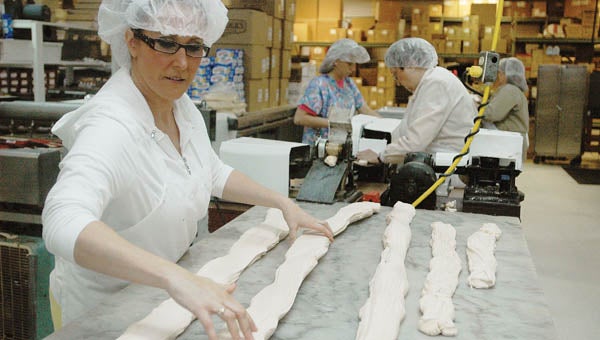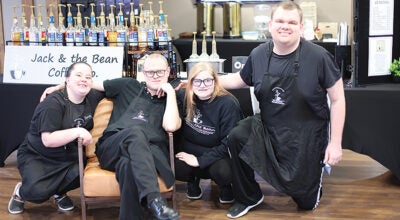Kentucky candy maker Ruth Hunt continues sweet legacy
Published 3:29 pm Sunday, July 24, 2011

Lynn Isaac pulls softened cream into long lines to be taken through a machine to make the Blue Monday candy bars.
Ruth Hunt didn’t invent old-fashioned Kentucky cream candy, but one could certainly say she perfected it.
Just bite into one of her famous Blue Monday bars, and as the soft cream melts in your mouth, you can taste the history that began 90 years ago with Ruth Hunt Candies.
Hunt’s sweet legacy began in 1921 in the basement of her Mt. Sterling, Ky., home, selling candies to family and friends. With nothing but word-of-mouth marketing, her small business venture began to outgrow itself.
In 1930, she found a permanent shop and factory to keep up with the rising demand of her cream candies, caramels, butter creams and assorted chocolates.
But factory or not, Hunt was not going to sacrifice taste for cost. Only the finest ingredients were to be used in each of her treats, with no deviation from her recipes.
The same is still true today. Even the methods of production are hardly modern, with most of the candies still wrapped by hand.
“By staying true to the recipes, and really the methods of making the candy, that’s what got us here the past 90 years,” said Toby Moore, manager of Ruth Hunt Candies. “That’s what I think you have to stay true to.”
Moore has been with the company since 1988, the year that Larry and Charles Kezele bought the factory from Hunt’s daughter, Emily Peck.
“When Larry bought the business in ‘88, we really didn’t change anything,” Moore said. “We kept the recipes of course and really focused on trying to bring it up to modern times as far as the marketing campaigns.”
In 2000, the facility was moved to Maysville Road, just off of Interstate 64, in a bustling new area of Mt. Sterling. This allowed for an expansion of the gift shop and ample room for groups to tour the factory.
It is a uniquely sweet experience to see how Ruth Hunt Candies still makes their signature Blue Monday bar, as well as how the bar got its name.
The story goes, Hunt had developed a cream bar, but didn’t know what to call it. One day, a minister stopped by the shop. He said he liked to stop in on Mondays, because he needed a cure for his blue Mondays.
If anything can cure a blue Monday, it is one of Hunt’s old-fashioned cream bars.
“To describe the taste, generally what we do is just hand people a piece,” Moore said. “Sampling is the best way.”
The lifecycle of a Blue Monday is truly something to behold.
Cream, sugar, butter and water come to a rolling boil in large copper kettles, stirred by chief cook, Junior Carroll. One batch will make up to 300 Blue Monday bars.
After the liquid comes to 260 degrees, Carroll uses a kettle lift to hoist the large vat from its burner, to a larger steel table, where it is poured out. As it hits the cool surface, the caramel colored liquid begins to solidify and become pliable. Carroll works the leathery-looking flat Blue Monday center with his hands, flipping it over like a large pizza dough, until he rolls it up like a carpet.
Carroll then transfers the roll to the puller. In the old days, Ruth Hunt would use a large hook on the wall to hold the cream. The hook is still there. Now, a machine pulls the cream just like saltwater taffy, one of the few modern advancements of the factory.
As air is pulled into the cream, it turns a pearly white.
Then, Debbie Maddox, Michelle Hatton and others on the production crew use large shears to cut the cream into thick strips.
This stage of the cream is what they call “chewy.”
“A lot of people, at Christmas, will come in and say, ‘I want to get a pound of chewy,’” said Moore. “Once it creams off, it’s like a totally different candy.”
The thick strips are laid on a marble slab table, the same ones used in Hunt’s original factory. The crew turns them so they won’t cool too quickly and crack.
“There is really no automated way to make cream candy,” Moore said. “It’s such a hand-made process.”
The thick strips of cream are shaped and fed through a small set of rollers that scores the surface. When the cream firms, the scores will mark where to snap apart.
The cream squares are placed on sheet pans and are now ready to be coated in chocolate.
When the squares are placed on the conveyor belt, they are just blocks of cream. When they emerge from the other side, they are Blue Mondays, coated in rich, single origin dark chocolate from Africa.
“Even though it gets increasingly challenging to continue making candy using the old methods, we do not want to go to a scenario where we’re loading the candy with preservatives and freezing it and changing the whole niche that we’ve been successful in,” Moore said. “You have to be creative and try to come up with different ways to remain competitive.”
To keep up with the demand for Blue Mondays and other cream candy, a machine wraps them. Other candies, such as the mallows, caramels and suckers, are still hand-wrapped.
As much as the company has grown, it has still remained a small family of workers, dedicated to keeping the legacy of Ruth Hunt alive.
“We’re a small factory, but we’re a big family,” said Mae Allen.
Allen has worked at the factory for 36 years, filing orders, waiting on customers and answering the phone. She knew both Ruth and Emily.
“She was particular about her candy,” she said of Hunt. “She didn’t want it scarred up. She’d say, ‘Oh look. You’ve hurt my little candy.’ Miss Peck was a different lady than her mother. She and I were friends and we shared a lot of secrets over the years.”
Ruth Hunt Candies has managed to keep their old-fashioned ways intact while continuing to grow and reach new customers.
The retail shop carries all of Hunt’s traditional candies: Blue Monday bars, bourbon balls, caramel, butter creams and assorted chocolates. The factory produces more than 50 varieties of candy.
The shop also carries other Kentucky based products like jams, sorghum, hot sauces, University of Kentucky gear, leather products and coffee mugs.
“I always stop here whenever I’m in Mt. Sterling,” said customer Meg Palmer. Palmer said when she moved to Lexington from Cincinnati, she stopped in one day to give it a try.
“The bourbon balls are great,” she said. “I think everything is good here. I haven’t tried anything I didn’t like.”
From the days when Ruth and her daughter Emily delivered candy on a horse and buggy, to shipping online orders from their website through UPS, the company has become an historical landmark in Kentucky.
As Moore puts it, “(Hunt) had to be a remarkable lady to accomplish that.”





